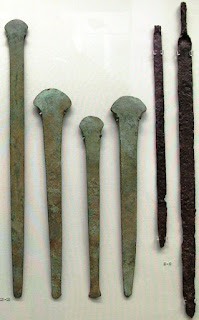
The Story of Indian Money – Part I
The recent excitement about the new symbol for the Indian Rupee created a huge tsunami of excitement in the Indian media as it symbolized India’s rise in the hierarchy of the select group of nations with similar privileges.
However, the event also brought the focus on the antiquity of Indian money and most newspapers scrambled for more information on this neglected topic in Indian History.
Hurried research by columnists made us faintly aware of the creation of the Indian denomination ‘Rupaiya’ or the modern Rupee during Sher Shah Suri’s reign clearly overlooking that the word ‘Rupaiya’ came from a more ancient Sanskrit term ‘Rupa’ meaning an image impressed on a metal.In India, like everywhere else, the idea of ‘money’ did not evolve overnight and had to undergo a parallel evolution with humans’ growth from pre-historic barbarians to the comfort-seeking creatures of today.
India has the longest and unbroken tradition of monetary evolution stretching three millennia or more and its money underwent dynamic changes with the rise and fall of numerous kingdoms and dynasties in the Indian sub-continent. Hence, the study of Indian money is essentially a kaleidoscopic study of the Indian civilisation itself in its varied hues.
The Pre-historic era (2.6 million years ago - 5000 B.C.)
The Indian sub-continent has seen continuous human occupation right from the beginning of of Stone Age’s hunter-gatherer stage (2.6 million years ago) into a settled human existence supported by farming and animal domestication during the Neolithic period (~ 8000 B.C.) Running parallel to this evolution has been the growth of human capability of trading beginning in the Palaeolithic Era (2.6 million years- 12000 B.C.) with simple barter of edible goods against stone tools and weapons. Indian archaeologists have found evidences of such exchanges in the form of ‘factory sites’ of tools which suggest mass production of stone tools for bartering.
The succeeding periods of prehistoric era viz. Mesolithic Era (12000 B.C. – 8000 B.C.) and Neolithic Era (8000 B.C. – 5000 B.C.) saw more sophistication in barter system with the evolution of primitive money in the form of ‘money objects’.
This is suggested by hoards of ‘money objects’ like arrow heads, iron filings, bead money, copper implements and cowry shells (in lands far away from the sea) found all over India’s numerous pre-historic sites. Archaeologists have inferred that these objects were used to ‘buy’ other valuable objects since they were perceived as ‘valuable’ by the primitive people. Thus, the pre-historic period helped train humans in the essential art of mutual exchange. However, the period was interspersed with sporadic violence over the ‘perceived inequities’ fostered by this primitive trading.
The major drawback of barter, though it survived for a long long time, was the excessive reliance on a mutual need for exchange between the concerned individuals; a condition that made trading a probable cause for strife in pre-historic society.
Barter objects are found often in archaeological excavations spanning all periods especially the prehistoric era. One famous example is the Copper Hoards found in Central India where Copper tools of various types are found huddled in form of a typical factory site. The British Museum's Coin Gallery exhibits a typical Copper hoard found from Ghungeria, Madhya Pradesh as an example of this prehistoric culture.
Thus, the idea of money in this primitive period thus centred upon exchange of metallic objects either in form of domestic or mechanical tools or weapons for self defence in exchange for other goods.
(To be continued)
I am fascinated reading your blog! I'm doing a presentation on Money from ancient times to now...and all my prior reading kept telling me that the oldest coins are from Lydia. I couldn't accept that as I know trade existed in India and China far longer...
ReplyDeleteDo you have any thoughts on which civilization issued the oldest coins?
Thanks for a really entertaining and informative blog!
Radhika
Radhika thanks for your interest. Regret the late reply. The race for which coins came first has no end as there can be no conclusive proof for either.
Delete